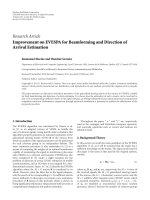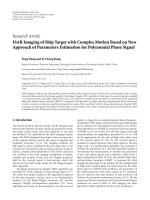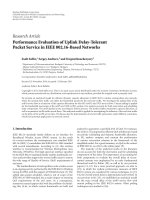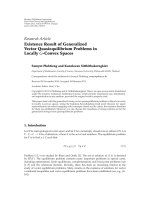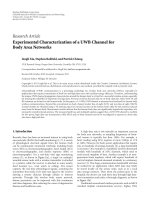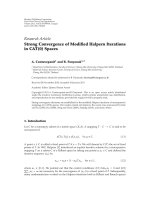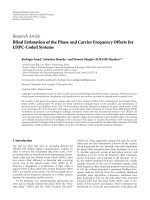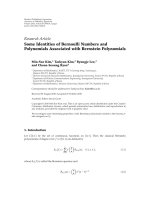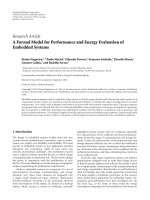Báo cáo hóa học: " Research Article Experimental Evaluation of Adaptive Modulation and Coding in MIMO WiMAX with Limited " docx
Bạn đang xem bản rút gọn của tài liệu. Xem và tải ngay bản đầy đủ của tài liệu tại đây (1.98 MB, 12 trang )
Hindawi Publishing Corporation
EURASIP Journal on Advances in Signal Processing
Volume 2008, Article ID 837102, 12 pages
doi:10.1155/2008/837102
Research Article
Experimental Evaluation of Adaptive Modulation and
Coding in MIMO WiMAX with Limited Feedback
Christian Mehlf
¨
uhrer, Sebastian Caban, and Markus Rupp
Institute of Communications and Radio-Frequency Engineering, Vienna University of Technology,
Gusshausstrasse 25/389, 1040 Vienna, Austria
Correspondence should be addressed to Christian Mehlf
¨
uhrer,
Received 22 June 2007; Revised 3 October 2007; Accepted 28 November 2007
Recommended by Ana P
´
erez-Neira
We evaluate the throughput performance of an OFDM WiMAX (IEEE 802.16-2004, Section 8.3) transmission system with adaptive
modulation and coding (AMC) by outdoor measurements. The standard compliant AMC utilizes a 3-bit feedback for SISO and
Alamouti coded MIMO transmissions. By applying a 6-bit feedback and spatial multiplexing with individual AMC on the two
transmit antennas, the data throughput can be increased significantly for large SNR values. Our measurements show that at small
SNR values, a single antenna transmission often outperforms an Alamouti transmission. We found that this effect is caused by the
asymmetric behavior of the wireless channel and by poor channel knowledge in the two-transmit-antenna case. Our performance
evaluation is based on a measurement campaign employing the Vienna MIMO testbed. The measurement scenarios include typical
outdoor-to-indoor NLOS, outdoor-to-outdoor NLOS, as well as outdoor-to-indoor LOS connections. We found that in all these
scenarios, the measured throughput is far from its achievable maximum; the loss is mainly caused by a too simple convolutional
coding.
Copyright © 2008 Christian Mehlf
¨
uhrer et al. This is an open access article distributed under the Creative Commons Attribution
License, which permits unrestricted use, distribution, and reproduction in any medium, provided the original work is properly
cited.
1. INTRODUCTION
With the theoretical understanding of the nature of multiple
antenna systems in a scattering environment by Winters
[1], Foschini and Gans [2], and Telatar [3], an enormous
potential for high spectral efficiency was found. This gave
the motivation to include multiple antenna systems in
wireless transmission standards like UMTS [4], WiMAX [5],
and WLAN [6]. A summary of all these standardization
efforts is given in [7]. They have in common that the
amount of feedback information is limited to a few bits
per transmission frame, preventing the implementation of
optimal beamforming solutions [8–10] that allow for close-
to-capacity performance.
In this work, we measure the throughput performance
of a SISO/MIMO OFDM system that uses the coding
and modulation schemes defined in the WiMAX standard
IEEE 802.16-2004 [5, Section 8.3], and [11]. The feedback
mechanism in WiMAX is limited to 3 bits by which one out
of seven possible adaptive modulation and coding (AMC)
schemes is selected, for example, depending on the received
SNR.
Multiple transmit antennas are incorporated into the
WiMAX standard by Alamouti space-time coding [12]at
the transmitter, thus increasing the available receive SNR
and the spatial diversity. This allows to reuse the same
feedback as in the SISO case for the Alamouti coded system.
In addition to Alamouti space-time coding, we consider
spatial multiplexing with individual AMC at every of the two
transmit antennas as an extension to the WiMAX standard
[13]. In particular, four different transmission modes were
implemented and measured.
(Mode 1) This mode is the standardized single transmit
antenna system with 3-bit feedback.
(Mode 2) This is the standardized two-transmit-antenna
system with Alamouti coding with also 3-bit
feedback.
(Mode 3) This is a spatial multiplexing, that is, two-
transmit-antenna system using 3-bit feedback
2 EURASIP Journal on Advances in Signal Processing
(equal coding rate at both antennas). This mode
is incorporated in the following mode but its
throughput is evaluated separately.
(Mode 4) This is a spatial multiplexing, two-transmit-
antenna system using 6-bit feedback (individual
coding rate at both antennas).
The measured data throughput of these transmission modes
is compared to the mutual information of the wireless
channel when the transmitter has no channel knowledge.
Previous work in this field is based either on simulations
[14–16] or on channel sounding experiments that yield
channel coefficients and channel capacities for different
scenarios [17, 18]. To the authors’ knowledge, no work exists
so far where the data throughput of a MIMO WiMAX system
is measured and compared to the mutual information of
the channel. Such a comparison is of utmost importance to
identify potential weaknesses of a transmission system and to
propose possible enhancements.
The paper is organized as follows. Section 2 presents
the transmitter and receiver algorithms used to generate
the transmit signals and to evaluate the receive signals,
respectively. Section 3 provides an overview of the Vienna
MIMO testbed and the setup of transmitter and receiver in
our measurement scenarios. In Section 4, we introduce a so-
called “perfect” AMC feedback method. Section 5 includes
a derivation of the achievable data throughput based on
the mutual information of the channel. The measured
data throughput is presented in Section 6.InSection 7,we
draw our conclusions. In Appendix A we substantiate our
findings from the measurement results by simulating the
system performance in a well-defined environment. Finally,
in Appendix B the SNR gains of improved channel estimators
are evaluated.
2. BASEBAND PROCESSING
In this section, the data generation at the transmitter and
the data processing at the receiver are explained for the four
different transmission modes considered in our experiments.
Specifically, we distinguish between SISO/SIMO transmis-
sion, MISO/MIMO transmission with Alamouti space-time
coding, and MIMO transmission with spatial multiplexing.
In the case of a single transmit antenna and for Alamouti
mode, a single data stream is transmitted, while for spatial
multiplexing, two independently coded and modulated data
streams are transmitted.
2.1. Transmitter
At first, random data bits are generated and then coded
by a concatenated Reed-Solomon (RS) and convolutional
encoder (see Figure 1). The systematic outer RS code uses
a codeword length of 255 bytes, a data length of 239 bytes,
and a parity length of 16 bytes. Depending on the currently
selected AMC value, the RS code is shortened (to allow for
smaller block sizes) and punctured. The outer convolutional
code of rate R
= 1/2 is generated by the polynomials 171
OCT
and 133
OCT
. This code belongs to the class of the so-called
maximum free distance codes with constraint length seven.
However, after puncturing depending on the AMC value, the
maximum free distance is reduced to d
free
= 6forR = 2/3,
d
free
= 5forR = 3/4, and d
free
= 4forR = 5/6, respectively,
d
free
= 10).
After coding, an interleaver is implemented to avoid
long runs of low reliable bits at the decoder input. The
interleaved bits are mapped adaptively to a symbol alphabet.
The coding, interleaving, and symbol mapping are the same
as defined in the WiMAX IEEE 802.16-2004 specification [5].
Depending on the feedback information from the receiver,
the mapping and the coding rate are adjusted. The seven
possibilities for the AMC schemes are summarized in Tab le 1 .
When Alamouti transmission is selected, the symbols are
additionally space-time coded to generate the transmit
symbols for both antennas. For spatial multiplexing, the
SISO encoding and modulation mapping are used for both
transmit antennas separately, leading to a total number of 7
× 7 = 49 AMC schemes.
After mapping the bits to symbols, serial-to-parallel
conversion is carried out to form OFDM symbols (256
carrier OFDM with 192 data symbols). Pilots, training
symbols, a zero DC carrier, and guard carriers are added
as defined in [5]. After an inverse fast Fourier transfor-
mation (IFFT), a cyclic prefix is added. We chose a cyclic
prefix length of 1/4 of the total OFDM symbol length to
avoid intersymbol interference in all measurement scenarios.
Before transmitting over the wireless channel, the signal is
normalized by a factor 1/
N
T
(with N
T
corresponding to the
number of transmit antennas), ensuring equal total signal
power for single and multiple antenna transmissions. Note
that base stations are subject to a power constraint by the
telecommunications regulator. To satisfy such a constraint,
we introduced the above normalization. Therefore, in SISO
transmissions the single transmit antenna radiates twice the
power of each (2 TX) MIMO antenna.
2.2. Receiver
At the receiver, we first perform the inverse operations of
the transmitter, that is, cyclic prefix removal, FFT, extraction
of data carriers and training symbols. The training symbols
(one symbol on the even subcarriers of transmit antenna
one and one symbol on the odd subcarriers of transmit
antenna two) are used for least-squares channel estimation.
The least-squares channel estimator was chosen here since
it is of very low complexity. (Note that according to the
standard [5] for the WiMAX training sequences, the least
squares channel estimation reduces to one multiplication
per estimated channel coefficient.) For reference purposes
an LMMSE channel estimator and a genie driven channel
estimator that uses all data symbols for channel estimation
were also implemented. (The noise variance, required for
LMMSE channel estimation [19], was estimated at the zero
DC carrier. This is possible because we are using a low
intermediate frequency avoiding IQ imbalance problems.
Note also that transmitter and receiver were synchronized by
means of Rubidium frequency standards avoiding frequency
offsets between the oscillators.). Unless otherwise stated,
Christian Mehlf
¨
uhrer et al. 3
Data bits
RS
encoder
Puncture
Convolutional
encoder
Puncture
Symbol
mapping
STC
AMC information from receiver
To OF D M
modulator
Figure 1: Encoding and modulation at the transmitter.
Table 1: The WiMAX AMC schemes in our setup for single antenna and Alamouti transmission. For spatial multiplexing, a separate AMC
scheme can be used for every transmit antenna. These frame sizes correspond to 44 OFDM data symbols transmitted in a frame duration of
2.5 milliseconds.
AMC scheme Data bits per frame Modulation Coding rate Max. throughput
(1) 4224 2-PAM 1/2 1.69 Mbps
(2) 8448 4-QAM 1/2 3.38 Mbps
(3) 12672 4-QAM 3/4 5.07 Mbps
(4) 16896 16-QAM 1/2 6.76 Mbps
(5) 25344 16-QAM 3/4 10.14 Mbps
(6) 33792 64-QAM 2/3 13.52 Mbps
(7) 38016 64-QAM 3/4 15.21 Mbps
all measurement results are based on least-squares channel
estimation.
The channel estimates and the data symbols are passed
to a max-log-MAP (maximum a posteriori) demapper.
The demapper for the spatial multiplexing transmissions is
implemented as a soft output sphere decoder with a single-
tree search [20]. The resulting soft bits are passed to a Viterbi
decoder and then to a Reed-Solomon decoder.
3. MEASUREMENTS
When it comes to measuring systems with feedback, there are
basically three approaches.
(i) One might build a demonstrator [21] where the
whole system (including the feedback) [22] is imple-
mented in real-time.
(ii) One might use a testbed where the received data is
evaluated “quickly” (e.g., in Matlab or C) and the
feedback is carried out via a LAN-connection. In such
a scenario, round trip times (receiver algorithm in
Matlab + LAN + transmitter algorithm in Matlab
+ loading the data into the testbed) are usually
in the order of 100 milliseconds up to a second,
depending on the effort put into the implementation.
This feedback method is especially interesting for
indoor scenarios where the channel stays constant
over such long periods of time, if carried out, for
example, at night. In outdoor scenarios, trees, cars,
and other constantly moving uninfluenceable objects
may prohibit such a measurement.
(iii) One might not use feedback at all but transmit a
block of data for every possible feedback combina-
tion, to evaluate these blocks later on. Of course, this
is only realizable in the case of limited feedback.
Approaches one and two require the knowledge of some
method to select the AMC scheme. These two approaches
are not applicable if the method of extracting the feedback
bits from the received data is yet to be found. Also, only
one particular feedback method can be investigated in one
measurement. We therefore decided to implement the third
approach, explained in detail in the following. This approach
has the advantage that also an optimal feedback method
can be investigated allowing to benchmark other realistic
methods based on, for example, the received SNR.
3.1. Measurement setup
For our measurements, we utilize the Vienna MIMO testbed
described in [23] enhanced by new power and low-noise
amplifiers. The basic features of the testbed are as follows.
(i) Baseband processing is carried out offline in Matlab
with floating-point precision. The transmitted and
received down-sampled signals are stored on hard
disk drives (approximately 600 Gbytes per scenario
measured).
(ii) Receiver and transmitter are synchronized by means
of rubidium frequency standards and a LAN connec-
tion.
(iii) The carrier frequency is 2.5 GHz; the bandwidth is
5 MHz.
(iv) The two transmit antennas [24]aremountedona
pole 16 meters above rooftop (downtilt ten degrees)
with a horizontal spacing of 2.75λ (see Figure 2).
Both antennas have two connectors for +45 and
−45
polarized antenna elements. The results presented in
this paper are based on measurements which utilized
only the +45 polarized elements of each antenna (
=
two equally polarized antennas, horizontally spaced
4 EURASIP Journal on Advances in Signal Processing
by 2.75λ). Reference measurements using the two
different polarizations of only one antenna yielded
the same conclusions and are therefore not further
discussed in this paper.
(v) The receive antennas are placed on a stepper-motor-
controlled linear XY positioning table. This table was
placed at three positions resulting in the following
three measurement scenarios.
(a) In Scenario 1, the table was placed two floors
below the transmit antenna in the same build-
ing having a non-line-of-sight connection.
(b) In Scenario 2, the table was placed in a non-line-
of-sight connection in the courtyard next to the
transmit antenna.
(c) A line-of-sight connection was established in
Scenario 3 by placing the table with the receive
antennas in the adjacent building (Figure 2).
These three practical scenarios represent three different
locations of a user accessing the internet via a WiMAX
connection.
3.2. Measuring a scenario
For each of the scenarios, we transmitted the following blocks
of data (Figure 3).
(a) A 2.5-millisecond long block, encoded according
to every possible feedback value (AMC value), was
transmitted.
(b) Consecutively, 7 SISO blocks, 7 Alamouti coded
blocks, and 7
×7 blocks employing spatial multiplex-
ing were transmitted.
(c) The resulting 7+7+7
×7 = 63 blocks were transmitted
at 15 different transmit power levels (28 dBm down
to
−2 dBm in steps of 2 dB) which was achieved by
analog attenuation of the transmitted signal prior to
the power amplifier.
(d) After reception, the resulting 15
×(7+7+7×7) blocks
were stored on hard disks for offline processing in
Matlab. The mean performance of a specific sce-
nario was obtained by repeating the above described
transmission at 502 different positions of the receive
antenna uniformly distributed within an area of 4λ
×
4λ (corresponding to a distance of 0.18λ between the
measurement positions). Note that more positions
within the same area would not significantly increase
the accuracy of the results because the channel
realizations become correlated. The only method to
increase the number of realizations is to increase the
measurement area, but this would lead to undesired
large-scale fading effects.
3.3. Measured channels
The method of successively transmitting all AMC schemes
requires that the channel stays constant during the trans-
mission of the 63 blocks to obtain meaningful throughput
5.5 λ
2.75 λ
TX
RX
1.2 λ
x-axis
Figure 2: Transmit and receive antenna setups in the outdoor-to-
indoor LOS scenario.
results. Large channel coherence time was achieved by
performing the outdoor-to-indoor measurements in the late
evening and by locking up the room with the receiver.
The outdoor-to-outdoor measurements were also performed
in a closed courtyard where no persons/objects moved
around.
The time-invariance of the frequency response from
transmit antenna one to receive antenna one is illustrated
in Figure 4. In this figure, the estimated channel coeffi-
cients of the successively transmitted data blocks (at the
same overall transmit power level) are plotted on top of
each other. The estimated channel coefficients include all
amplification and attenuation factors (including transmit
power normalization) applied to the signal after the training
signal generation. These attenuation factors are thus part
of the estimated channel. Because of the transmit power
normalization, the frequency responses of the seven SISO
AMC schemes are 3 dB larger than the frequency responses
of the MIMO AMC schemes. It should be emphasized that
the channel characteristics (gain and receiver noise variance)
stay constant also for the transmission at different transmit
power levels.
Besides the 3 dB normalization factor, all frequency
responses in Figure 4 show a very good agreement. The
differences between the frequency responses are only given by
the channel estimation error. By estimating the same channel
with different noise realizations several times in a Matlab
simulation, we could verify that the measured errors in the
frequency response are in the same order as the channel
estimation error.
Christian Mehlf
¨
uhrer et al. 5
(a)
AMC = 1
AMC
= 2
AMC
=
3
···
AMC =
last
t
(b)
SISO
Alamouti
Spatial
multiplexing
7x 7x 49x
t
(c)
Tr an smi t
power
= 28 dBm
= 26 dBm
=
24 dBm
···
=−2dBm
t
(d)
Position 1
Position 2
Position 3
···
Position 502
t
Save data
to HDD
+
move
antennas
Figure 3: Structure of the transmitted data blocks, (a) is a zoomed
version of (b).
−30
−20
−10
0
10
20
30
|h
1,1
|
2
σ
2
n
(dB)
20 40 60 80 100 120 140 160 180
Sub carrier index
SISO
MIMO
3dB
Figure 4: Estimated channel coefficients for the SISO as well
as the MIMO cases between transmit antenna one and receive
antenna one, scenario 1, NLOS outdoor-to-indoor. The coefficients
are plotted over the 192 data subcarriers; the eight pilots and
the zero DC carrier are left out. Note that the transmitter
attenuation is included in these estimated channel coefficients
leading to 3 dB smaller channel coefficients for MIMO transmis-
sions.
Because of the above described reasons, we can consider
the scenarios as quasistatic during all transmissions at a given
receive antenna position.
4. BEST AMC SELECTION
We define the best possible AMC selection as the one that
maximizes the data throughput. Since all AMC schemes
are transmitted consecutively over approximately the same
channel, we can evaluate all schemes and select the one
that achieves the highest throughput. This perfect feedback
scheme and the method of calculating the data throughput
for this scheme will be explained in the following.
We calculate the data throughput for the following
receiver schemes.
Single receive antenna schemes
(i) SISO transmission of a single data stream.Thereceiver
selects one of the seven AMC schemes shown in Table 1 . This
requires a 3-bit feedback for every frame.
(ii) 2
× 1 MISO transmission of a single Alamouti space-
time coded data stream. The same AMC schemes as for the
SISO transmission are employed.
Dual receive antenna schemes
(i) SIMO transmission of a single data stream with maximum
ratio combining at the receiver. The same AMC schemes as for
the SISO transmission are employed.
(ii) MIMO transmission of a single Alamouti space-time
coded data stream with maximum ratio combining at the
receiver. Again, the same AMC schemes as for the SISO
transmission are employed.
(iii) 2
× 2 MIMO transmission of two data streams.Both
data streams are encoded by the same modulation and coding
scheme. The feedback effort here is therefore the same as in
the SIMO transmission, that is, 3 bits.
(iv) 2
× 2 MIMO transmission of two independent
data streams. Every data stream is encoded and modulated
as defined for the SISO transmission, leading to a total
combination of 7
× 7 = 49 schemes with an overall
feedback effort of 6 bits. Note that this mode includes all
possible modulation and coding schemes of the previous
transmission mode.
At a specific channel realization c
= 1, , N
RXpos
and a
specific transmit attenuator value m
= 1, , 15, we calculate
the best instantaneous data throughput as
D
(c,m)
best
= max
i∈I
R
i
1 −P
(c,m)
i
,(1)
where R
i
corresponds to the data rate of the ith adaptive
modulation and coding scheme (i
∈ I,whereI is the set
of all adaptive schemes) and P
(c,m)
i
∈{0, 1} is a frame error
indicator. (It is convenient here to use a frame error indicator
instead of the BER as a basis for the data throughput
calculation since at low SNR the BER converges to 0.5.
Therefore, simply counting the correctly detected bits would
give too large values for the data throughput.) In this work,
we assume that one frame is equal to one transmission
block defined in Section 3. The data throughput at one
transmit attenuation value is found by averaging over all
6 EURASIP Journal on Advances in Signal Processing
channel realizations (N
RXpos
receiver positions) at a specific
attenuation m:
D
(m)
best,avg
=
1
N
RXpos
N
RXpos
c=1
D
(c,m)
best
. (2)
Note that (2) gives the absolute maximum data throughput
that is possible with the available transmission schemes.
This data rate can only be achieved by a genie-driven AMC
selection that knows the block errors of all transmission
schemes already before the actual transmission. In a real
system, the selection of an appropriate AMC value would
have to rely on the channel state information and the
estimated noise variance to predict the block errors for
all AMC schemes. The nontrivial problem of selecting the
appropriate AMC value is not addressed in this work.
5. ACHIEVABLE DATA THROUGHPUT
In this section, we derive an expression for the “achievable”
data throughput that can be used as a performance bound
for the measured data throughput. This expression is based
on the mutual information between transmit and receive
signals, that is, the estimated frequency response. The
achievable data throughput is only a function of the wireless
channel and does not depend on the AMC schemes used in
the measurements.
Consider the mutual information of an AWGN channel
with the SNR ρ:
I
= log
2
{1+ρ},(3)
In theory, a transmission can achieve a rate corresponding to
this mutual information. This requires that the transmitter
adapts the coding rate to the receive SNR. Therefore, the
receiver has to feed back which AMC value the transmitter
has to use. In WiMAX, seven AMC schemes corresponding
to 3-bit feedback are defined.
The mutual information for transmitting symbols over
a MIMO channel (which correspond to the mutual infor-
mation of the kth subcarrier of the OFDM system) can be
expressed as [2, 3]
I
(c,m)
k
= log
2
det
I
N
R
+
1
σ
2
n
H
(c,m)
k
H
(c,m)H
k
. (4)
(In literature, the mutual information is often referred to
as “capacity without channel knowledge at the transmitter.”
However, the capacity is a property of the channel and cannot
depend on the particular implementation of a transmission
system (e.g., with or without full channel knowledge at the
transmitter). We will therefore base the calculation of the
achievable data throughput on the mutual information.)
Equation (4) assumes that the transmitter has no knowledge
about the channel, and thus the transmit power is distributed
equally over the antennas. Using (4), we can estimate the
theoretically achievable transmission rate by substituting
the true channel matrix H
(c,m)
with the estimated channel
matrix H
(c,m)
est
. To improve the accuracy of the mutual
information, we use the channel matrices estimated by the
genie-driven channel estimator that utilizes all transmitted
data symbols. Additionally, we calculate the channel matrices
for large transmit attenuator values from the estimated
channel matrix at the smallest transmit attenuator value
H
(c,m)
est
=
A
m
A
1
H
(c,1)
est
, m = 2, ,15. (5)
Here, A
m
denotes the mth transmit attenuation value and A
1
corresponds to the smallest attenuation. The noise variance
σ
2
n
is also substituted by the estimated noise variance. It
is approximately the same at both receive antennas with a
difference of about 1 dB.
The overall mutual information I
(m)
sum
for the OFDM
system at one transmit attenuation value m can now
be calculated by summing the mutual information of all
subcarriers and averaging over the N
RXpos
(the realizations)
different receiver positions:
I
(m)
sum
=
1
N
RXpos
N
RXpos
c=1
192
k=1
I
(c,m)
k
. (6)
Since the transmission of an OFDM signal requires also
the transmission of a cyclic prefix to avoid intersymbol
interference, and a preamble for synchronization and chan-
nel estimation, the mutual information given by (6)can
never be achieved. It is therefore convenient to introduce
an “achievable” data throughput D
(m)
achievable
that accounts for
these inherent system losses. We define the achievable data
throughput at the transmit attenuation value m as
D
(m)
achievable
=
1
1+G
·
1/T
s
256
·
N
data
N
OFDM
·I
(m)
sum
,(7)
where G (1/4 in our measurements) corresponds to the
ratio of cyclic prefix time and useful OFDM symbol time,
N
data
(44 in our measurements) is the number of OFDM
data symbols, N
OFDM
(47 in our measurements) is the total
number of OFDM symbols in one transmission frame,
and T
s
corresponds to the sampling rate of the transmit
signal. The factor (1/T
s
)/256 is therefore equivalent to the
available bandwidth per subcarrier. In our measurements,
we chose a channel bandwidth of 5 MHz. For this channel
bandwidth, the WiMAX standard defines a sampling rate
of T
s
= 1/5.76 MHz. The 5.76 MHz total signal bandwidth
emerging from this sampling rate fits into the 5 MHz channel
bandwidth because some of the guard band carriers (with
zero energy) are outside the 5 MHz channel bandwidth.
Equation (7) will be used as a performance bound for
comparisons with the measured data throughput in the next
section.
6. RESULTS
In this section, we present the measured data throughput
results and give explanations for the observed performance.
In order to account for all possible losses in the transmission
chain, the curves presented in this section are plotted over
the transmit power rather than over the received SNR [25].
Christian Mehlf
¨
uhrer et al. 7
0
5
10
15
20
25
30
Throughput (Mbit/s)
0481216202428
Transmit power (dBm)
Achievable throughput
Single TX (1)
Single TX (2)
Dual TX
1
×1
2
×1Alamouti
Figure 5: Scenario 1, measured (solid) and achievable (dashed)
data throughput in the NLOS outdoor-to-indoor scenario using one
receive antenna. The largest transmit power corresponds to a receive
SNR of about 22 dB.
6.1. Scenario 1—NLOS outdoor-to-indoor
In this scenario, the receiver was placed three floors below the
transmit antenna mounted on a pole on the roof, resulting
in a non-line-of-sight outdoor-to-indoor connection. The
scenario is characterized by strong frequency selectivity
and hence large frequency diversity. The measured data
throughput is shown for one and two receive antennas in
Figures 5 and 6,respectively.InFigure 5, we observe that
the achievable data throughput is approximately the same
for a two-transmit-antenna transmission and a transmission
on the first transmit antenna only. The achievable data
throughput of the second transmit antenna is a little bit lower
than that of the first transmit antenna.
One would expect from simulation results that Alamouti
transmission greatly outperforms SISO transmission in such
a strong frequency selective scenario (see Appendix A.2 for a
simulation result in an ITU Pedestrian B channel). The gain
of the Alamouti transmission over the SISO transmission
is caused by the ability to “flatten” the frequency response
of the channel by utilizing the spatial diversity. This, in
turn, increases the probability of correctly decoding the
received frame. Unfortunately, Alamouti transmissions are
more sensitive to channel estimation errors than SISO
transmissions (see, e.g., the derivation of the bit error
probability of a 2
× 1 Alamouti transmission and a 1 × 2
transmission with maximum ratio combining in [26]). This
results in a loss of all performance gains of the Alamouti
coded system, as shown in Figure 5. In addition to the
higher sensitivity of the Alamouti transmission to channel
estimation errors, also the channel estimator performance
in the Alamouti case is worse than in the SISO case.
The reason for this lies in the fact that in a two-antenna
transmission the available transmit power is split between
antennas causing the received training to be of 3 dB lower
SNR. In this scenario, the performance of the Alamouti
transmission can be enhanced by a better channel estimator.
0
5
10
15
20
25
30
Throughput (Mbit/s)
0481216202428
Transmit power (dBm)
Achievable throughput
Single TX (1)
Single TX (2)
Dual TX
1
×2
2
×2Alamouti
2
×2SM,6bit
2
×2SM,3bit
Best of all schemes
Figure 6: Scenario 1, measured (solid) and achievable (dashed)
data throughput in the NLOS outdoor-to-indoor scenario using
two receive antennas. The largest transmit power corresponds to a
receive SNR of about 22 dB.
0
5
10
15
20
25
30
Throughput (Mbit/s)
−50 5101520
Estimated mean SNR (dB)
Achievable throughput
Single TX (1)
Dual TX
1
×2
2
×2Alamouti
2
×2SM,3bit
2
×2SM,6bit
Best of all schemes
Figure 7: Scenario 1, measured (solid) and achievable (dashed)
data throughput in the NLOS outdoor-to-indoor scenario using
two receive antennas.
If, for example, LMMSE channel estimation is implemented,
the Alamouti transmission could gain about 1.2dB over the
SISO transmission (see also Ta ble 2 in Appendix B for a list
of channel estimation gains).
The throughput results for the two-receive-antenna
transmission in the same scenario are shown in Figure 6.
Again, the Alamouti transmission performs worse than the
single antenna transmission because of the same reasons
described above. The spatial multiplexing scheme with 6-bit
feedback allows for a throughput increase of about 20%
at large transmit power. The spatial multiplexing scheme
with only 3-bit feedback, that is, when only equal data
rates are supported on both antennas, shows only the same
performance as the Alamouti transmission. The curves show
clearly that a throughput increase can only be achieved if the
spatial coding is adapted on a per transmit antenna basis. In
8 EURASIP Journal on Advances in Signal Processing
our case, this is achieved by changing the coding rate, but the
same effect may also be achieved by Alamouti coding with
a subsequent power loading on the transmit antennas. This,
however, requires that both power amplifiers are capable of
transmitting at the full output power of the SISO system
(3 dB more than in the MIMO case).
The “best of all schemes” curve shows the data through-
put if the best transmission scheme is selected from the
set of all possible AMC schemes at every receiver position
(for every channel realization). This means that not only
the AMC scheme is adapted to the channel but also the
transmission mode, that is, single stream, Alamouti, or
spatial multiplexing. In the low SNR region, the single
stream transmission is selected most of the time; in the
high SNR region, spatial multiplexing achieves the largest
data throughput. Note that the “best of all schemes”
throughput is sometimes larger than the throughput of the
individual transmission modes. This is due to the individual
selection of the transmission modes for every channel
realization.
Figure 7 shows the throughput in the same scenario
plotted over receive SNR. The throughput for the 1
×2system
here is equal to the throughput of the 2
×2 Alamouti system.
In contrast, when these curves are plotted over transmit
power, the 1
× 2 system shows an advantage of about 1 dB
over the Alamouti system. When comparing systems with
adifferent number of transmit antennas (e.g., SISO with
Alamouti), we encounter the fact that the two transmit
antennas do not have the same average channel gain. If those
systems are compared over receive SNR, the throughput
curves are shifted and, therefore, the results look different.
For this reason, we plot all curves over transmit power rather
than over receive SNR.
6.2. Scenario 2—NLOS outdoor-to-outdoor
In this scenario, the receive antennas were placed in a non-
line-of-sight connection in the courtyard next to the building
with the transmit antennas on the roof. The results for
this scenario with strong frequency selectivity are shown
in Figures 8 and 9. In contrast to the previous scenario, a
transmission over the second transmit antenna leads to a
much higher achievable throughput than a transmission over
the first antenna. Therefore, adding the second antenna at the
transmitter by Alamouti coding yields a significant through-
put increase. On the other hand, if the SISO transmission
had been performed over the second transmit antenna,
Alamouti coding would have worsened the performance.
We therefore conclude that in such a strongly asymmetric
scenario, antenna selection is a promising alternative.
Figure 9 shows that the 2
× 2 transmission already
achieves such a large SNR that the data throughput for
the single stream transmission saturates (since no larger
AMC values are available). In this SNR region, the usage of
spatial multiplexing yields a large throughput increase. Also,
due to the strongly asymmetric scenario, the 6-bit spatial
multiplexing system greatly benefits from the adjustable code
rate per transmit antenna.
0
5
10
15
20
25
30
Throughput (Mbit/s)
0481216202428
Transmit power (dBm)
Achievable throughput
Dual TX
Single TX (1)
Single TX (2)
1
×1
2
×1Alamouti
Figure 8: Scenario 2, measured (solid) and achievable (dashed)
data throughput in the NLOS outdoor-to-outdoor scenario using
one receive antenna. The largest transmit power corresponds to a
receive SNR of about 24 dB.
0
5
10
15
20
25
30
Throughput (Mbit/s)
0481216202428
Transmit power (dBm)
Achievable throughput
Dual TX
Single TX (1)
Single TX (2)
1
×2
2
×2Alamouti
2
×2SM,6bit
2
×2SM,3bit
Best of all schemes
Figure 9: Scenario 2, measured (solid) and achievable (dashed)
data throughput in the NLOS outdoor-to-outdoor scenario using
two receive antennas. The largest transmit power corresponds to a
receive SNR of about 24 dB.
6.3. Scenario 3—LOS outdoor-to-indoor
In this scenario, a line-of-sight connection was established
by placing the receive antennas inside a building adjacent
to the building with the transmit antennas on the roof. The
measured data throughput is shown for one and two receive
antennas in Figures 10 and 11, respectively. This scenario is
characterized by a strong line-of-sight component leading to
Rician distributed flat fading channels. The Rician K factor
[27]wasestimatedtobeK
= 2.9. (The Rician K factor is
defined as the relation between the energy of the nonfading
line-of-site (specular) component and the energies of the
diffuse fading components, K
= s
2
/2σ
2
, given pdf(x) =
(x/σ
2
)exp−((x
2
+ s
2
)/2σ
2
)I
o
(xs/2σ
2
).)
Christian Mehlf
¨
uhrer et al. 9
0
5
10
15
20
25
30
Throughput (Mbit/s)
0481216202428
Transmit power (dBm)
Achievable throughput
Dual TX
Single TX (1)
Single TX (2)
1
×1
2
×1Alamouti
Figure 10: Scenario 3, measured (solid) and achievable (dashed)
data throughput in the LOS outdoor-to-indoor scenario using one
receive antenna. The largest transmit power corresponds to a receive
SNR of about 32 dB.
0
5
10
15
20
25
30
Throughput (Mbit/s)
0481216202428
Transmit power (dBm)
Achievable throughput
Dual TX
Single TX (1)
Single TX (2)
1
×2
2
×2Alamouti
2
×2SM,6bit
2
×2SM,3bit
Best of all schemes
Figure 11: Scenario 3, measured (solid) and achievable (dashed)
data throughput in the LOS outdoor-to-indoor scenario using two
receive antennas. The largest transmit power corresponds to a
receive SNR of about 32 dB.
The Alamouti code looses a lot of performance compared
to the transmission with a single antenna. Here, in contrast
to the previous two scenarios, the loss is caused by the flat
fading channel (see Appendix A for simulation results). It
is well known that in flat fading channels, the diversity can
be increased by Alamouti coding. At a fixed modulation and
coding scheme, the Alamouti coded system therefore has an
increasing SNR advantage for large SNR values. However,
since we are considering a coded system with adaptive
modulation and coding, the operating points on the uncoded
BER curves are between BER
= 10
−1
and BER= 10
−2
.At
these large BER values, the SNR gain due to Alamouti
coding is only very small [28, pages 777–795] and vanishes
when coded frame error rate or data throughput is plotted.
Appendix A shows a simulation result for a flat fading
Rice scenario (similar to the measured one) where the
same effect can be observed. Additionally, Alamouti coding
looses because of the poor channel estimation, as discussed
above.
The 2
× 2 spatial multiplexing system suffers in this
scenario from the line-of-sight component. For low transmit
power, the performance is worse than the 1
× 2per-
formance.However,forlargetransmitpower(>16 dBm),
the throughput of the single stream transmission already
saturates allowing for huge performance gains of the spatial
multiplexing schemes. In such a scenario with a line-of-
sight connection to the basestation, either new AMC values
with larger data rate or spatial multiplexing should be
implemented.
6.4. Discussion of the throughput loss
The measured throughput curves presented in the previous
sections have in common that they are far (>10 dB) away
from the achievable throughput. We identified the following
factors as the main sources of the SNR loss.
(i) The largest loss is caused by the too simple convolu-
tional channel coding which shows a relatively slow
decline of the coded BER curve. The slow decline of
the coded BER curve also leads to poor frame error
ratio (FER) performance for large block lengths. (The
frame error probability P
f
for a frame of N
f
bits
can be calculated from the bit error probability P
b
as
P
f
= 1 − (1 −P
b
)
N
f
.) As shown in Appendix A, the
convolutional coding already costs >6.5 dB in SNR
for a SISO transmission over a flat Rayleigh fading
channel. Our preliminary assessments show that this
loss can be decreased greatly if better channel codes
(LDPC or Turbo codes) are employed.
(ii) According to the standard, only one OFDM training
symbol per frame is used, leading to poor channel
estimator performance. Additionally, in the MIMO
transmissions, the power splitting between the two
transmit antennas leads to the reception of the
training with 3 dB smaller SNR, worsening the
channel estimator performance. The implementation
of a perfect (genie-driven) channel estimator that
uses not only training but also the transmitted data
symbols for channel estimation shows that a 2
× 1
Alamouti transmission can gain about 2.9 dB and a
1
× 1 SISO transmission can gain about 1.2 dB in
SNR. If LMMSE channel estimation is employed, the
2
×1 Alamouti system can gain about 1.8 dB and the
1
× 1 SISO system can gain about 0.6 dB over the
corresponding systems with LS channel estimation.
For a detailed list of values see Tabl e 2 in Appendix B.
(iii) The set of possible combinations of modulations and
code rates is suboptimal. The implemented feedback
scheme can therefore be only optimal for this given
set of AMC schemes.
10 EURASIP Journal on Advances in Signal Processing
7. CONCLUSIONS
In this paper, we investigated the throughput performance
of SISO and MIMO WiMAX systems with limited feedback.
Our evaluation is based on an extensive outdoor measure-
ment campaign using practical setups of the basestation
antennas and receiver positions. The comparison of the mea-
sured data throughput to the “achievable” data throughput,
given by the mutual information of the channel, reveals
a large loss (>10 dB in SNR). Even the single transmit
antenna schemes only achieve a fraction of the possible
data throughput. The largest part of this SNR/throughput
loss is caused by the simple convolutional coding (about
6.5 dB). By using improved coding techniques (LDPC or
Turbo codes), it should be possible to reduce this loss
greatly. Another significant part of the SNR/throughput loss
is caused by simple LS channel estimation. Depending on
the transmission scheme, this loss is between 0.6 dB and
3.2 dB. The implementation of a WiMAX system therefore
requires improved channel coding (e.g., the optional block
Turbo code of the WiMAX standard) and enhanced channel
estimators.
The comparisons between the different schemes revealed
that Alamouti and spatial multiplexing transmissions (3-
bit feedback) loose performance compared to SIMO and
spatial multiplexing (6-bit feedback) transmissions. This
is caused by the asymmetric gains of the MIMO chan-
nel. Therefore, also asymmetric transmission schemes are
required to achieve high performance. Asymmetric trans-
mission on two antennas can be accomplished by spatial
multiplexing with individual coding and modulation for
each transmit antenna, as investigated in the paper. Other
possibilities may be, for example, transmit antenna selection
or Alamouti transmission with subsequent power loading
on the two transmit antennas. This, however, would require
that both transmit amplifiers support the full transmit
power of the SISO amplifiers (3 dB more than the MIMO
amplifiers).
A very general conclusion of this work is that the
overall performance of a communication system obviously
depends on several factors. If a single part of a system is
not implemented properly (e.g., channel coding, channel
estimation), the overall system performance is substantially
reduced. Only a thorough investigation comparing measured
throughput to achievable throughput (given by the mutual
information of the wireless channel) reveals whether all parts
of a wireless system are properly configured. In the special
case of WiMAX 802.16-2004, our performance analysis
reveals that the optional channel coding schemes should be
implemented before the optional MIMO extensions since
advanced channel coding promises substantially larger gains.
APPENDICES
A. SIMULATIONS
In this appendix, we present some additional results confirm-
ing the statements in Section 6.
0
2
4
6
8
10
12
14
16
Throughput (Mbit/s)
−50 5101520
SNR (dB)
Achievable throughput
∼ 8dB
∼ 5.5dB
AMC7
AMC6
AMC5
AMC4
AMC3
AMC2
AMC1
Figure 12: Simulated throughput performance of the SISO system
with perfect channel knowledge in an AWGN channel.
0
2
4
6
8
10
12
14
16
Throughput (Mbit/s)
−50 5101520253035
SNR (dB)
Achievable throughput
∼ 8dB
∼6.5dB
Simulated throughput
Figure 13: Simulated throughput performance of the SISO system
with perfect channel knowledge in a flat Rayleigh fading channel.
A.1. SISO performance
In this section, we investigate the performance loss of the
simple convolutional coding and the limited number of
AMC schemes. As can be observed in the AWGN simulations
in Figure 12, the loss to the achievable throughput is about
5.5 dB for AMC values one and two. For larger AMC
values, where the convolutional coding is combined with
puncturing to enable higher code rates, the corresponding
loss is even higher. This is also reflected in Figure 13 where
the throughput of a SISO system over a flat Rayleigh fading
channel is plotted. The throughput loss here is about 6.5 dB
for small SNR values and increases with the SNR. The reason
for this increasing throughput loss is that at a specific (mean)
SNR value the probability that the largest AMC value is
selected increases. Since no larger AMC values are available,
the throughput slowly saturates until it reaches its maximum.
Christian Mehlf
¨
uhrer et al. 11
0
2
4
6
8
10
12
14
16
18
20
Throughput (Mbit/s)
0 5 10 15 20 25 30
SNR (dB)
2
×1 Alamouti perfect CSI
1
×1 perfect CSI
1
×1 estimated CSI
2
×1 Alamouti estimated CSI
Figure 14: Simulated throughput performance for perfect and
estimated channels, Pedestrian B channel model without spatial
correlation.
A.2. SNR loss due to channel estimation
A.2.1. Frequency selective channel
The first comparison (Figure 14) shows the simulated data
throughput of the one receive antenna system in an ITU
Pedestrian B [29] environment. No correlation was assumed
between the transmit antennas. The figure shows the
throughput for estimated and perfectly known channels.
When perfect channel state information (CSI) is available
at the receiver, the Alamouti transmission has superior
performance over the SISO transmission throughout the
entire SNR range. When the channel is estimated at the
receiver, the Alamouti transmission looses about 2.4 dB in
SNR, much more than the SISO (0.8 dB) leading to only
slightly better performance of the Alamouti transmission
in the high SNR region. One reason for the poor channel
knowledge in the two-transmit-antenna case is the power
splitting on the two transmit antennas. This leads to the
reception of the training with 3 dB smaller SNR and, hence,
a worse channel estimate than in the SISO case (see also
Figure 4). Another reason for the poor channel estimate
lies in the fact that the WiMAX standard defines only one
OFDM training symbol per transmit antenna not allowing
for an enhanced channel estimator that makes use of several
training symbols.
A.2.2. Flat fading LOS scenario
In this simulation, we compare the throughput performance
of 2
×1 Alamouti transmission to the 1×1 SISO transmission
in a flat fading Rice channel with K
= 2.9. The results are
plotted in Figure 15. When perfect channel state information
is available at the receiver, the 2
× 1and1× 1systems
show the same performance; only at a large SNR, Alamouti
coded transmission has a small advantage. Since the system
operates at a high uncoded BER, the diversity gain of the
Alamouti code is not reflected in the data throughput. Note
0
2
4
6
8
10
12
14
16
18
20
Throughput (Mbit/s)
0 5 10 15 20 25 30
SNR (dB)
2
×1 Alamouti perfect CSI
1
×1 perfect CSI
1 ×1 estimated CSI
2
×1 Alamouti estimated CSI
Figure 15: Simulated throughput performance for perfect and
estimated channels, flat fading Rice channel with K
= 2.9.
Table 2: SNR gains of improved channel estimators over the LS
estimator.
Scenario 1 LMMSE genie-driven
1 ×1 SISO 0.6 dB 1.2 dB
2
×1 Alamouti 1.8 dB 2.9 dB
1
×2 SIMO 0.5 dB 1.2 dB
2
×2 Alamouti 1.9 dB 3.2 dB
2
×2 Spatial Multiplexing (3 bit) 1.4 dB 2.4 dB
2
×2 Spatial Multiplexing (6 bit) 1.1 dB 2.2 dB
the difference to the previous simulation in the Pedestrian B
environment where Alamouti has a 2 dB gain over the SISO
transmission. In the frequency selective case, the Alamouti
code “flattens” the frequency response and thus avoids deep
fades (that would inhibit the correct decoding of the received
frame) of some subcarriers. Therefore, space-time coding
has the ability to increase the data throughput in frequency
selective channels and not in flat fading channels.
B. SNR GAINS OF IMPROVED CHANNEL ESTIMATORS
To quantify the SNR loss of the simple least-squares chan-
nel estimator, the received data were also evaluated with
improved channel estimators. In particular, LMMSE channel
estimation and genie-driven channel estimation were con-
sidered. The genie-driven estimator uses all transmitted data
symbols (44 OFDM symbols) to obtain a channel estimate.
Ta ble 2 shows the SNR gains of these improved channel
estimators over the least-squares estimator for measurement
scenario one. In scenarios 2 and 3, the SNR gains of the
improved channel estimators are approximately the same. A
difference of only
±0.2 dB was observed [30].
ACKNOWLEDGMENTS
The authors would like to thank Arpad L. Scholtz, Lukas
W. Mayer, Klaus Doppelhammer, Peter Brunmayr, Christian
12 EURASIP Journal on Advances in Signal Processing
Raschko, Robert Langwieser, Michael Fischer, and Werner
Keim. Without their valuable contributions to the testbed,
these measurements could not have been performed. The
authors would also like to thank Professor Kathrein for
providing the basestation antennas for their measurement
campaign. This work has been funded by the Christian
Doppler Laboratory for Design Methodology of Signal Pro-
cessing Algorithms (see />REFERENCES
[1] J. H. Winters, “On the capacity of radio communication
systems with diversity in a rayleigh fading environment,” IEEE
Journal on Selected Areas in Communications,vol.5,no.5,pp.
871–878, 1987.
[2] G. J. Foschini and M. J. Gans, “On limits of wireless
communication in a fading environment when using multiple
antennas,” Wireless Personal Communications,vol.6,no.3,pp.
311–335, 1998.
[3] E. Telatar, “Capacity of multi-antenna Gaussian channels,”
European Transactions on Telecommunications, vol. 10, no. 6,
pp. 585–595, 1999.
[4] 3GPP, “Technical specification group radio access network;
physical layer—general description,” Tech. Rep. 25.201 V7.2.0,
3GPP, 2007, />series/
25.201/25201-720.zip.
[5] IEEE, “IEEE standard for local and metropolitan area net-
works; part 16: air interface for fixed broadband wireless
access systems, IEEE Std. 802.16-2004,” October 2004, http://
standards.ieee.org/getieee802/download/802.16-2004.pdf.
[6] IEEE, “IEEE draft standard for local and metropolitan area
networks; part 11: wireless LAN medium access control
(MAC) and physical layer (PHY) specifications: amend-
ment: enhancements for higher throughput, IEEE Draft Std.
802.11n(d2),” 2007.
[7] A. Hottinen, M. Kuusela, K. Hugl, J. Zhang, and B.
Raghothaman, “Industrial embrace of smart antennas and
MIMO,” IEEE Wireless Communications,vol.13,no.4,pp.8–
16, 2006.
[8] P.Kyritsi,D.C.Cox,R.A.Valenzuela,andP.W.Wolniansky,
“Capacity and rate performance of MIMO systems with chan-
nel state information at the transmitter,” IEEE Transactions on
Wireless Communications, vol. 5, no. 12, pp. 3469–3478, 2006.
[9] P. Xia, S. Zhou, and G. B. Giannakis, “Adaptive MIMO-OFDM
based on partial channel state information,” IEEE Transactions
on Signal Processing, vol. 52, no. 1, pp. 202–213, 2004.
[10] J. C. Roh and B. D. Rao, “Multiple antenna channels with
partial channel state information at the transmitter,” IEEE
Transactions on Wireless Communications,vol.3,no.2,pp.
677–688, 2004.
[11] />[12] S. M. Alamouti, “A simple transmit diversity technique for
wireless communications,” IEEE Journal on Selected Areas in
Communications, vol. 16, no. 8, pp. 1451–1458, 1998.
[13] A. Ghosh, D. R. Wolter, J. G. Andrews, and R. Chen, “Broad-
band wireless access with WiMax/802.16: current performance
benchmarks, and future potential,” IEEE Communications
Magazine, vol. 43, no. 2, pp. 129–136, 2005.
[14] F. Wang, A. Ghosh, R. Love, et al., “IEEE 802.16e system
performance: analysis and simulations,” in Proceedings of the
16th IEEE International Symposium on Personal, Indoor and
Mobile Radio Communications (PIMRC ’05), vol. 2, pp. 900–
904, Berlin, Germany, September 2005.
[15] B. Muquet, E. Biglieri, and H. Sari, “MIMO link adaptation
in mobile wimax systems,” in Proceedings of the IEEE Wireless
Communications and Networking Conference (WCNC ’07),pp.
1810–1813, Kowloon, Hong Kong, March 2007.
[16] T. H. Chan, M. Hamdi, C. Y. Cheung, and M. Ma, “Overview
of rate adaptation algorithms based on MIMO technology in
WiMAX networks,” in Proceedings of the IEEE Mobile WiMAX
Symposium, pp. 98–103, Orlando, Fla, USA, March 2007.
[17] A. F. Molisch, M. Steinbauer, M. Toeltsch, E. Bonek, and R.
S. Thom
¨
a, “Capacity of MIMO systems based on measured
wireless channels,” IEEE Journal on Selected Areas in Commu-
nications, vol. 20, no. 3, pp. 561–569, 2002.
[18] R. E. Jaramillo,
´
O. Fern
´
andez, and R. P. Torres, “Empirical
analysis of a 2
×2 MIMO channel in outdoor-indoor scenarios
for BFWA applications,” IEEE Antennas and Propagation
Magazine, vol. 48, no. 6, pp. 57–69, 2006.
[19] D. Schafhuber, M. Rupp, G. Matz, and F. Hlawatsch, “Adaptive
identification and tracking of doubly selective fading channels
for wireless MIMO-OFDM systems,” in Proceedings of the
4th IEEE Workshop on Signal Processing Advances in Wireless
Communications (SPAWC ’03), pp. 417–421, Rome, Italy, June
2003.
[20] C. Studer, M. Wenk, A. P. Burg, and H. B
¨
olcskei, “Soft-output
sphere decoding: performance and implementation aspects,”
in Proceedings of the 40th Asilomar Conference on Signals,
Systems and Computers (ACSSC ’06), pp. 2071–2076, Pacific
Grove, Calif, USA, November 2006.
[21] M.Rupp,C.Mehlf
¨
uhrer, S. Caban, R. Langwieser, L. W. Mayer,
and A. L. Scholtz, “Testbeds and rapid prototyping in wireless
system design,” EURASIP Newsletter, vol. 17, no. 3, pp. 32–50,
2006.
[22] T. Kaiser, A. Wilzeck, M. Berentsen, and M. Rupp, “Proto-
typing for MIMO systems—an overview,” in Proceedings of
the European Signal Processing Conference (EUSIPCO ’04),pp.
681–688, Vienna, Austria, September 2004.
[23] S. Caban, C. Mehlf
¨
uhrer, R. Langwieser, A. L. Scholtz, and M.
Rupp, “Vienna MIMO testbed,” EURASIP Journal on Applied
Signal Processing, vol. 2006, Article ID 54868, 13 pages, 2006.
[24] Kathrein, “Technical specification Kathrein antenna type no.
742 211,” />load/9362108g.pdf.
[25] S. Caban and M. Rupp, “Impact of transmit antenna spacing
on 2
× 1 Alamouti radio transmission,” Electronics Letters,
vol. 43, no. 4, pp. 198–199, 2007.
[26] D. Gu and C. Leung, “Performance analysis of transmit diver-
sity scheme with imperfect channel estimation,” Electronics
Letters, vol. 39, no. 4, pp. 402–403, 2003.
[27] C. Tepedelenlio
˘
glu, A. Abdi, and G. B. Giannakis, “The
Ricean K factor: estimation and performance analysis,” IEEE
Transactions on Wireless Communications,vol.2,no.4,pp.
799–810, 2003.
[28] J. G. Proakis, Ed., Digital Communications, McGraw-Hill, New
York, NY, USA, 3rd edition, 1995.
[29] “Recommendation ITU-R M.1225: Guidelines for evaluation
of radio transmission technologies for IMT-2000,” Tech. Rep.,
1997.
[30] C. Mehlf
¨
uhrer,S.Caban,andM.Rupp,“Anaccurateandlow
complex channel estimator for OFDM WiMAX,” in Proceed-
ings of the 3rd International Symposium on Communications,
Control, and Signal Processing (ISCCSP ’08), pp. 922–926, St.
Julians, Malta, March 2008.

